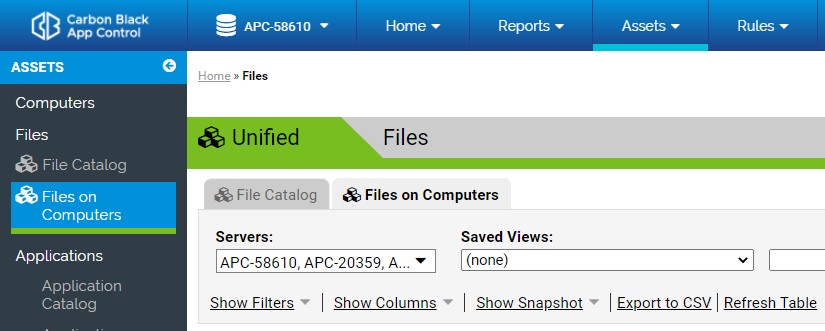The following features are available using Unified Management.
- Configuration of Unified Management – You can enable or deactivate Unified Management for your entire environment, designate a central management server, add or remove other servers from unified management, and determine which users can access unified management as users or as administrators.
- File Information – The file inventory for all servers under unified management is available through the central management server. File inventory includes the File Catalog, the Files on Computers list, and the File Details pages. In addition, you can search for a file on all managed servers in one operation.
- Rules – For many rule types, you can create and manage a rule on the central management server and have it apply to some or all of the managed servers. Rules include File Rules (approvals and bans), Custom Rules, Memory Rules, and Registry Rules.
- Single Sign-On from Management Server – After a user with unified management credentials is authenticated on a client server, that user can login to the client server directly from the management server without providing user name and password again.
- Events – New or modified events are added to track Unified Management activities. There is a new Unified events saved view on the Events page, and there is an optional Unified Server Source column that you can add to event tables.
- User Interface Changes – On menus, tabs, and page banners, a symbol showing three cubes together indicates that a feature has Unified Management enabled, and on pages that show results from multiple servers, the word “Unified” appears next to the page heading. For example, the following example shows the top of a Files on Computers page on a server with Unified Management enabled.

| App Control Page |
Unified Management Features |
|---|---|
| All (console menu bar) |
Log in to client servers from the management server without providing additional login credentials. Requires initial authentication for user. |
| File Catalog | View file inventory and act on files reported by the management server and all servers reporting to it. |
| Files in Computers | View inventory and act on files instances reported by all unified servers. |
| File Details | View file details and act on a file reported by any unified server. |
| Find Files | Find instances of a file on all unified servers. |
| File Rules | Apply an approval or ban, or remove a ban or approval to file instances on any unified servers. Can be further defined by server and/or policy. |
| File Rules Details | Apply an approval or ban, or remove a ban or approval to file instances on any unified servers. Can be further defined by server and/or policy. |
| Custom Rules | Apply, enable, or deactivate a rule on any unified servers. Can be further defined by server and/or policy. |
| Custom Rule Details | Apply, enable, or deactivate a rule on any unified servers. Can be further defined by server and/or policy. |
| Memory Rules | Apply, enable, or deactivate a rule on any unified servers. Can be further defined by server and/or policy. |
| Memory Rule details | Apply, enable, or deactivate a rule on any unified servers. Can be further defined by server and/or policy. |
| Registry | Apply, enable, or deactivate a rule on any unified servers. Can be further defined by server and/or policy. |
| Registry Rule Details | Apply, enable, or deactivate a rule on any unified servers. Can be further defined by server and/or policy. |